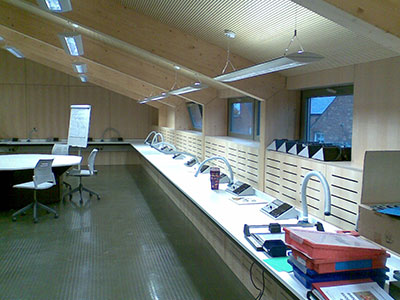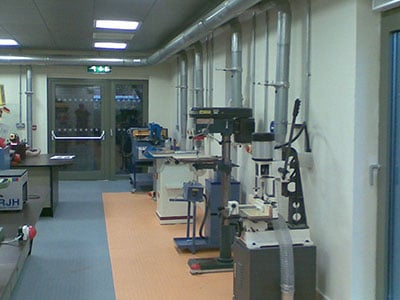 New Workshop Facility Built
New Workshop Facility Built
Oakham School in Rutland is a co-educational centre of excellence in creative and technology design for students from 10 to 18 years of age who are seeking to progress, via university or other teaching establishments, into specialist design careers in architecture, engineering or … in product design itself.
A new £2 million creative workshop facility at Oakham School is state of the art, with money having been invested in teaching systems, in the protection of the environment and in protecting the students them-selves. Dustraction won the contract for dealing with waste generated by a range of machines working in wood and wood based panels, as well as with other structural materials such as metals and plastics.
Dustrax Filter Unit Installed
The machinery and the Dustrax filter layouts meet the needs of creative and aspiring students and help the school to further enhance its reputation for producing talented designers and technologists, while also building on the strong links it has with today’s industrial and environmental codes of practice.
Two large multi-material workshops on the ground floor provide for the traditional processing of wood, metal and plastic and above them are two studios, one dedicated to computer aided design and manufacture and one to electronics, each housing a range of equipment synonymous with contemporary technology, including work stations for 50 personal computers.
The department maintains its links to the creative and applied arts with all disciplines very much in the spirit of the Bauhaus model and continues to adopt and encourage the use of new technologies.
Students use a wide range of media and processes including IT and CAD/CAM for metals, plastics and jewellery as well as wood and panel working in order to develop and manufacture their concepts. Skills, knowledge and understanding are developed while working to set briefs so that key areas of learning can be identified to cover all aspects of design and technology development.
Students working at a higher level are encouraged to research markets to establish the viability of their chosen design project alongside their own interests and passions.
As part of the environmental control system, Dustraction supplied an articulated arm for a wood lathe for optimum positioning by the operator to collect light and floating dust generated during spindle, turning and sanding procedures.
 Dustraction also supplied a normally closed floor sweep-up point to collect chip materials which fall to the floor in a teaching area which also houses pillar drills, bandsaws, milling machines, around a dozen bench mounted Hegna fret saws plus sanding and finishing operations.
Dustraction also supplied a normally closed floor sweep-up point to collect chip materials which fall to the floor in a teaching area which also houses pillar drills, bandsaws, milling machines, around a dozen bench mounted Hegna fret saws plus sanding and finishing operations.
Increased Performance and Low Noise
The air volume handled by the systems is 1.6 m3/sec (2,458 cfm), a capacity based on all machines being in operation at any one time. The collector of choice is a Dustrax No. 40M filter with a filtration area of 40 m2 (430 ft2) made up of multiple cotton filter elements operating at a filtration velocity of around 5.7 fpm.
The dynamically balanced assembly is fitted with a 7.5 kW motor and the fan impeller is of the high efficiency, backward inclined type designed for increased performance and low noise output. The unit is equipped with a fully automatic shaker mechanism activated on shut down, thereby reducing dependence upon the operator. Two circular storage bins, each of 100 litres capacity, are fitted with quick release toggle action sealing bands to ensure simple and clean removal of the collected dust and chip materials — the containers use standard waste bin liners.
Dust laden air enters the filter through the air inlet connection with the heavier particles being deposited straight into the bins. Fine particles of dust travel with the airstream and are retained on the inside surfaces of the filter fabric until dislodged by the auto-shaker. Cleaned air is drawn through the filter element into a low velocity chamber with a heavy duty plate-mounted fan set located above and the.cleaned air is discharged from a fan outlet via a low noise acoustic top chamber.
Oakham School students, Felicity Milton and James Malin, achieved the highest honours in the Young Engineers for Britain National Final in 2005. The competition is the most prestigious of its kind in Europe, challenging young people aged 10 to 19 to design and develop an original idea for a commercially viable device or a system that meets a useful everyday need. Felicity and James won the under 18 and under 16 years categories respectively — a single year achievement unique in the history of the competition.
